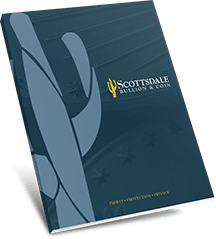
There’s more to investing in gold than meets the eye. Between physical gold bullion and rare coins to gold futures and gold ETFs, there are many ways to profit from the much-desired metal.
For thousands and thousands of years, humans have been captivated by the beautiful, shining luster of gold. The oldest gold coin known to numismatics pre-dates the birth of Christ by about 750 years, demonstrating a long and unbroken interest in the yellow metal. Gold holds its intrinsic value across time and across cultures, and has been especially valuable in the past decade. Today, there are several ways of buying gold, either as investments in stocks or owning physical gold. If you are interested in learning about how you can invest in gold to take advantage of gold price upswings, but are unsure what method is right for you, read on for an introduction to 5 common ways of investing in gold.
Option I: Gold Stocks
1. Exchange-Traded Funds
Each day, each hour, each minute, the gold price fluctuates. An ounce of gold worth $500 in the morning may be worth $510 by nightfall. Exchange-traded funds represent a relatively new method of profiting from market fluctuations because the individual purchases a security on the investment, rather than the investment itself. Even if you own billions of dollars in gold ETF investments, you are not actually buying gold—not even a single ounce Instead, you own the value of the net change in the price of gold, profiting as others buy the metal. It can seem a tad overwhelming for those with little investing experience, but it’s a good safeguard if your investments rely heavily on the dollar (or the euro, or the pound sterling). That’s because the price of gold usually rises as the dollar falls, so that a sluggish economy inspires more people turn to gold, thereby increasing the value of gold in any form.
2. Gold Futures
Think that the price of gold will rise steeply tomorrow? If you purchase a gold futures asset at the current price, you could make quite a bit of money. By contrast, if you think the gold price will fall, sell a gold futures sum at the current price and you’ll be sitting on more value. Such crystal ball gazing is the essence of buying gold futures: you do not exchange gold itself, but rather profit from the difference between its value change and an expected value change. Investors utilize gold futures as a speculation or a hedge for as far in the future as they can find a fellow investor. This can be a bit overwhelming for a first-time investor, but futures are often easier to trade than options. The upside is the flexibility and the value of pertinent information—those who do their homework in the gold industry will profit.
Option II: Physical Gold
3. Gold Accounts
Most people already keep important things at a bank — cash, mortgages, wills, family heirlooms, and investments. Why not ensure that your bank takes charge of the security and value of your gold as well? A gold account keeps the value of your investment at a bank in one of several different ways. An allocated account purchases gold and then keeps the metal in a secure location (the bank, a guarded warehouse, etc.). You own this gold and the bank acts as the provider. By contrast, an unallocated account does not store your gold, but rather uses it for the bank’s own investments. Once you determine you are ready to sell your metal, the bank gives you the gold value of the investments. The risks of an allocated account are lower—the gold doesn’t go anywhere since it’s not invested— but the rewards of an unallocated account are higher: you can profit more from the gold’s investment over time than from the value itself. In addition to such holdings, a gold IRA (individual retirement account) allows you to save for retirement buy purchasing certain types of gold bullion. A precious metal IRA allows for a multifaceted approach to investing, putting many eggs in many different baskets so that the net value rises even if one particular investment falls.

Everything you need to know to get started in Precious Metals
Learn how precious metals can strengthen your portfolio, protect your assets and leverage inflation.
Request the Free Guide4. Buy Gold Bullion
Some people like to own bullion in the form of gold bars—you can buy gold in bar form just like the government does. Bars of bullion, recognized as at least 99.5% pure, can be purchased at a per-ounce value of their gold concentration. The advantage of purchasing a bar of gold lies in the cost of the purchase: a smaller quantity, such as an ingot or a coin, carries a higher mark-up from the spot price, which is the current physical market price of the metal. Bullion can also be purchased in coin form. Many different countries produce their own bullion coins. The most popular from the U.S. is the American Eagle. Gold American Eagles come in 1oz, ½ oz, ¼ oz, and 1/10 oz increments. Both gold bullion bars and gold bullion coins are traded based on their weight value, and represent a high quality gold investment that is legitimately backed by a government and has standard levels of purity. The drawback lies in the security, however: unless you invest in a high-quality safe and insurance, your entire investment will be lost if stolen. People buy bullion for its dense physical quantity of gold as well as its physical presence—to some, it can be reassuring in a way that stock ownership papers cannot match.
5. Buy Gold Numismatic Coins
Those with an interest in investing, in history, and in holding their wealth in the palm of their hands may prefer investing in numismatic gold coins. Numismatic coins are different from bullion coins because in addition to their weight value, they also have a historical or rare value based on factors such as limited quantities, special marks or historic dates. Buying gold coins, whether in pre-confiscation era or from the Roman Empire, allows you to diversify your portfolio into an asset class that you can pass on to multiple generations. It provides the highest level of private wealth that is attainable in the U.S. today. Many obtain these coins for what is known in the industry as the three P’s: Privacy, Profit and Protection. What’s more, it’s a fun introduction to the world of gold investing. Those just starting out will need to find a certified gold dealer to ensure their coins are authentic and legitimate.
How To Get Started Buying Gold
Those wondering where to buy gold can contact Scottsdale Bullion and Coin for professional assistance in determining a coin’s precise value, as well as recommendations for other coins to enhance a portfolio or complement a collection. Be aware that the best place to buy gold isn’t a pawn shop or other dealers who may not be legitimate sellers.
The pathways to investing in gold are manifold and each carries its own risks and rewards. Investing in gold, however, allows you to take advantage of the healthy appetite for precious metals in the global market. What’s more, your own collection of gold can be a safeguard against market fluctuations and dollar inflation, due to the fact that you can always a ready buyer or seller, and you can count on gold to always retain value.
